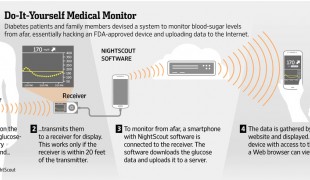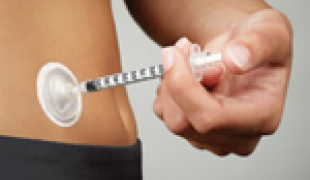- 5479
- 405
- 4
- 6
- 0
- Help Ukraine
About the solution
Type 1 diabetes is caused when the pancreas fails to produce enough insulin. Insulin is what helps the body turn glucose from sugar into energy. Without insulin, sugar builds up in the blood stream. With too much insulin, sugar can fall to dangerously low levels. For insulin-dependent diabetics, keep glucose levels stable is a constant challenge.
After Dana Lewis graduated in Alabama, USA, she moved to Seattle. She was an insulin-dependent diabetic and, living alone, she had a continuous glucose monitor and an insulin pump. The monitor would send her an alarm to warn her to eat sugar if glucose is too low, or to take insulin if blood sugar is too high. However, she felt like the alarm wasn’t loud enough.
"I sleep through the alarms on the device that are supposed to wake me up and save my life”, Dana said. To solve this, she used shared code on the internet to get the data off the device, then sent it to the cloud and back to her phone to be able to have louder alarms.
She also thought that, since she lived alone, it could be beneficial to have someone else see her data. That is when she programmed a web interface to be able to share it with her boyfriend and, if he did not respond, with her mother. Like this, if she had low blood sugar during the night and didn’t wake up with the alarm, her boyfriend would hear his alarm and would call her, so that she would wake up and drink some juice.
Then, she further developed the system so that it could predict if, in the near future, she was going to have low blood sugar, which allowed her to take action before the blood sugar was already too low. The predictions were based on an algorithm that used the available data.
She then wanted to find a way to have the insulin pump automatically adjusted according to her needs, instead of having to wake up and press a button on the pump to receive the insulin. For this, she used shared code from a collaborator who had figured out how to communicate and send commands directly to the insulin pump.
This allowed her to create her final solution, a computer (an Intel Edison chip can be used) which records data from what she has done, reads her blood sugar and determines, for example, that she needs more insulin. It then sends a direct command to the insulin pump to slightly increase the insulin administered during the next 30 minutes. After 5 minutes, it receives more data and evaluates the progress. With small adjustments every 5 minutes, the computer is capable of taking care of her insulin and sugar needs, in order to keep her blood sugar level stable.
In December 2014 the product was finally fully working, and Dana wanted to share it with the world. So, she launched a blueprint on the internet, calling it Open APS: Open-sourced pancreas system.
Since Dana shared her solution, hundreds of people have used the code to build their own device.
Adapted from: http://bit.ly/2MPOfgl
More info: openaps.org
This solution shall not include mention to the use of drugs, chemicals or biologicals (including food); invasive devices; offensive, commercial or inherently dangerous content. This solution was not medically validated. Proceed with caution! If you have any doubts, please consult with a health professional.
DISCLAIMER: This story was written by someone who is not the author of the solution, therefore please be advised that, although it was written with the utmost respect for the innovation and the innovator, there can be some incorrect statements. If you find any errors please contact the patient Innovation team via info@patient-innovation.com
-
-
728
-
0
-
16847

Nightscout – an open source, do-it-yourself continuous glucose monitor in the Cloud
CAREGIVING
(SELF)-CARE: EATING: Eating independently.
(SELF)-CARE: DRINKING: Drinking independently.
diabetes type 1
diabetes type 2
Gestational Diabetes
App (Including when connected with wearable)
Promoting self-management
Managing diabetes
To implement a diagnostic tool
Preventing (Vaccination, Protection, Falls, Research/Mapping)
Caregiving Support
Endocrinology
General and Family Medicine
Internal Medicine
United States
-
-
-
557
-
1
-
14390

Girl creates low-cost home dialysis machine
(SELF)-CONTROL: URINARY CONTINENCE: Maintaining urinary continence
Renal and Urinary Tract Injuries
Renal Disorders (Renal Obstructive Disorders, Renal Structural Abnormalities)
Pre-Renal Failure
Glomerulonephritis
Treatment/Surgical device
Abnormal urine color (e.g., dark, pale)
Changes in urine frequency or volume
Kidney failure
Blood in the urine (hematuria)
Decreased urine output
Flank pain (pain in the sides of the back)
Urinary tract infections
Cloudy or foul-smelling urine
Abdominal pain
Lower abdominal pain or discomfort
Urinary hesitancy (delayed or weak urine stream)
Fatigue
Pelvic pain
Preserving Organ Function
To improve Treatment/Therapy
Nephrology
Urology
Canada
-
-
-
735
-
0
-
14136

I-Port™ – Medication delivery device
-
 en
en